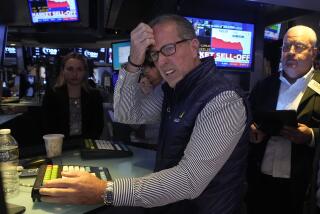Some Analysts Fear Worst Is Still to Come for Wall Street
NEW YORK — One of the greatest fears on Wall Street is that the last few weeks of corporate earnings warnings--and stock market losses--were just a rehearsal for what the market will probably endure as first-quarter results are reported in droves starting this week.
Amid the economy’s slowdown and pressure on corporate earnings from rising wages, increased energy costs and high debt loads, the numbers are expected to be the weakest year-over-year quarterly results in about a decade.
Earnings tracker First Call/Thomson Financial says analysts now expect earnings for the Standard & Poor’s 500 companies to be down 8.6% in the first quarter from a year earlier. In the second quarter the consensus is for an overall S&P; profit decline of 6.8%.
And though investors might think they’re prepared for the worst, analysts expect Wall Street to react badly.
“We have not entered the phase yet where the market is going to disregard bad news,” said A.C. Moore, chief investment officer for Dunvegan Associates in Santa Barbara. “There is a time when the nervous selling has been done, and when there is a scintilla of improvement ahead and when bad news tends to roll off. But we’re not there yet.”
A big question at this point is, what constitutes good or bad news?
If companies can simply meet lowered profit expectations, investors might consider that positive news, analysts say. It’s less clear whether investors will drive prices higher based on such reports, and, if they do, whether those gains can last.
“Six months ago, if you just said you were going to meet expectations, your stock would have been trashed,” said Ronald J. Hill, investment strategist at Brown Bros. Harriman & Co. in New York. “Now meeting expectations is the best anyone can hope for. . . . Just making numbers is probably going to be viewed as good news.”
Last week Dell Computer proved that just standing by weaker estimates can be enough to propel stocks higher--at least for a day. The news helped push the Dow Jones industrial average up 402.63 points, or 4.2%, to 9,918.05 Thursday, and the Nasdaq composite index up 146.20 points, or 8.9%, to 1,785.00.
“The market was looking for some reason to bounce,” said Charles White, portfolio manager for Avatar Associates, who called Thursday’s run-up a bear market rally.
But Friday’s trading session brought a fresh wave of selling. The Dow ended down 126.96 points, or 1.3%, at 9,791.09. Nasdaq fell 3.6% to 1,720.36.
The key to the market gaining some stability is for companies to at least meet lowered estimates, Hill said. However, Hill’s firm, Brown Bros., said last week it expects more companies than ever to miss already-reduced forecasts.
And as for truly good news--in other words, better-than-expected earnings--it sounds like investors can pretty much forget about it.
“There is a small chance you will get many upside surprises,” Hill said. “There will be companies like Circuit City, Bed Bath & Beyond and Best Buy, all of which beat estimates [last week], but they will be in the distinct minority.”
Investors who are also looking for companies to say the outlook for future profit is improving will probably be disappointed, said Hugh Johnson, chief investment officer for First Albany.
“We’ll be left with the view that the future is very, very unclear or cloudy,” Johnson said.
Among the major companies expected to report earnings this week are General Electric, Motorola, Yahoo and Juniper Networks.
More to Read
Inside the business of entertainment
The Wide Shot brings you news, analysis and insights on everything from streaming wars to production — and what it all means for the future.
You may occasionally receive promotional content from the Los Angeles Times.










